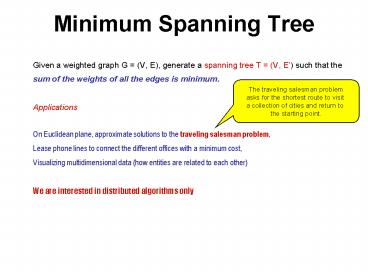Minimum Spanning Tree - PowerPoint PPT Presentation
Title:
Minimum Spanning Tree
Description:
Title: Concurrent Reading and Writing using Mobile Agents Author: Sukumar Ghosh Last modified by: Sukumar Ghosh Created Date: 11/1/2002 2:53:35 AM – PowerPoint PPT presentation
Number of Views:125
Avg rating:3.0/5.0
Title: Minimum Spanning Tree
1
Minimum Spanning Tree
- Given a weighted graph G (V, E), generate a
spanning tree T (V, E) such that the sum of
the weights of all the edges is minimum. - Applications
- On Euclidean plane, approximate solutions to the
traveling salesman problem, - Lease phone lines to connect the different
offices with a minimum cost, - Visualizing multidimensional data (how entities
are related to each other) - We are interested in distributed algorithms only
The traveling salesman problem asks for the
shortest route to visit a collection of cities
and return to the starting point.
2
Example
3
Sequential algorithms for MST
- Review (1) Prims algorithm and (2) Kruskals
algorithm. - Theorem. If the weight of every edge is
distinct, then the MST is unique.
4
Gallagher-Humblet-Spira (GHS) Algorithm
- GHS is a distributed version of Prims algorithm.
- Bottom-up approach. MST is recursively
constructed by fragments joined by an edge of
least cost.
3
7
5
Fragment
Fragment
5
Challenges
Challenge 1. How will the nodes in a given
fragment identify the edge to be used to connect
with a different fragment? A root node in each
fragment is the coordinator
6
Challenges
Challenge 2. How will a node in T1 determine if
a given edge connects to a node of a different
tree T2 or the same tree T1? Why will node 0
choose the edge e with weight 8, and not the edge
with weight 4? Nodes in a fragment acquire the
same name before augmentation.
7
Two main steps
- Each fragment has a level. Initially each node is
a fragment at level 0. - (MERGE) Two fragments at the same level L combine
to form a fragment of level L1 - (ABSORB) A fragment at level L is absorbed by
another fragment at level L (L lt L)
8
Least weight outgoing edge
- To test if an edge is outgoing, each node sends
a test message through a candidate edge. The
receiving node may send accept or reject. - Root broadcasts initiate in its own fragment,
collects the report from other nodes about
eligible edges using a convergecast, and
determines the least weight outgoing edge.
test
accept
reject
9
Accept of reject?
- Let i send test to j
- Case 1. If name (i) name (j) then send reject
- Case 2. If name (i)?name (j)?level (i) ? level
(j) then send accept - Case 3. If name (i) ? name (j) ? level (i) gt
level (j) then wait until level (j) level (i).
WHY? - Levels can only increase.
- Question Can fragments wait for ever and lead to
a deadlock?
reject
test
test
10
Delayed response
test
A
B
join
initiate
Level 3
Level 5
B is about to change its level to 5. So B does
not send an accept reponse to A in response to
test
11
The major steps
- repeat
- Test edges as outgoing or not
- Determine lwoe - it becomes a tree edge
- Send join (or respond to join)
- Update level name identify new coordinator
- until done
12
Classification of edges
- Basic (initially all branches are basic)
- Branch (all tree edges)
- Rejected (not a tree edge)
- Branch and rejected are stable attributes
13
Wrapping it up
Example of merge
- Merge
- The edge through which the join
- message is sent, changes its status to
- branch, and becomes a tree edge.
- Each root broadcasts an
- (initiate, L1, name) message
- to the nodes in its own fragment.
14
Wrapping it up
- Absorb
- T receives an initiate message.
- This indicates that the fragment at
- level L has been absorbed by the
- other fragment at level L. They
- collectively search for the lwoe.
- The edge through which the
- join message was sent, changes
- its status to branch.
initiate
Example of absorb
15
Example
8
0
2
1
5
1
3
7
4
5
4
6
2
6
3
9
16
Example
8
merge
merge
0
2
1
5
1
3
7
4
5
4
6
2
merge
6
3
9
17
Example
8
0
2
1
5
1
7
4
merge
3
5
4
6
absorb
2
6
3
9
18
Example
absorb
8
0
2
1
5
1
7
4
3
5
4
6
2
6
3
9
19
Message complexity
At least two messages (test reject) must pass
through each rejected edge. The upper bound is
2E messages. At each of the log N levels, a
node can receive at most (1) one initiate message
and (2) one accept message (3) one join message
(4) one test message not leading to a rejection,
and (5) one changeroot message. So, the total
number of messages has an upper bound of 2E
5N logN






























